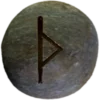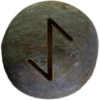Last Updated on January 17, 2025


Hrungnir (pronounced HROONG-neer) is a prominent figure in Norse mythology. He is a jötunn, or giant, who appears in the Prose Edda by Snorri Sturluson. His name, which translates to “brawler” or “strong one,” emphasizes his immense strength and belligerent nature. In Old Norse, the word “Hrungnir” is spelled with a thorn (þ), but modern conventions render it as an “h.” ![]()
The story of Hrungnir unfolds in the tale of his infamous duel with Thor, the thunder god. According to the Prose Edda, Hrungnir traveled to Asgard, home of the gods, after boasting about his superior strength and challenging Thor. Despite his intimidating size and prowess, the gods managed to intoxicate Hrungnir, leading to a reckless series of events. This encounter set the stage for his eventual confrontation with Thor.
During their duel, Hrungnir wielded a massive whetstone as a weapon, symbolizing his raw power. Thor countered with Mjölnir, his legendary hammer. The clash ended with Thor shattering Hrungnir’s whetstone and defeating the giant. However, a piece of the broken whetstone lodged in Thor’s head, which became a mark of their fierce battle. ![]()
Hrungnir’s death is remembered not just for the heroism of Thor but also for the chaotic energy giants brought into the mythological world. He is described as being made of stone, with a heart, head, and shield of unbreakable rock. His narrative reflects the ongoing struggle between the gods and jötnar, which shaped much of Norse cosmology.
Runes Associated with Hrungnir
Two Elder Futhark runes symbolically connect with Hrungnir. The first is Thurisaz (ᚦ), representing giants and powerful destructive forces. Thurisaz (THOO-ree-saz) embodies primal energy and chaos, traits central to Hrungnir’s persona. The thorn-like shape of the rune mirrors the jagged strength of the jötnar. ![]()
The second rune is Eihwaz (ᛇ), linked to endurance and the struggle between opposing forces. Eihwaz (AY-wahz) signifies the balance of destruction and protection. This resonates with the duel, where Hrungnir’s force clashed with Thor’s divine might. These runes capture the essence of Hrungnir’s presence in the mythological narrative.
His Importance to Asatru
Hrungnir’s story holds symbolic significance for modern Asatruar. His role illustrates the ever-present tension between chaos and order. For many, his narrative serves as a cautionary tale about pride and recklessness. Hrungnir’s defeat by Thor emphasizes the triumph of determination over raw strength.
Hrungnir’s rocky form and immense power remind practitioners of the natural world’s formidable aspects. The gods’ ability to overcome such threats inspires resilience and confidence. Reflecting on Hrungnir’s tale helps Asatruar connect with myths that honor courage and the pursuit of balance in a tumultuous world.

